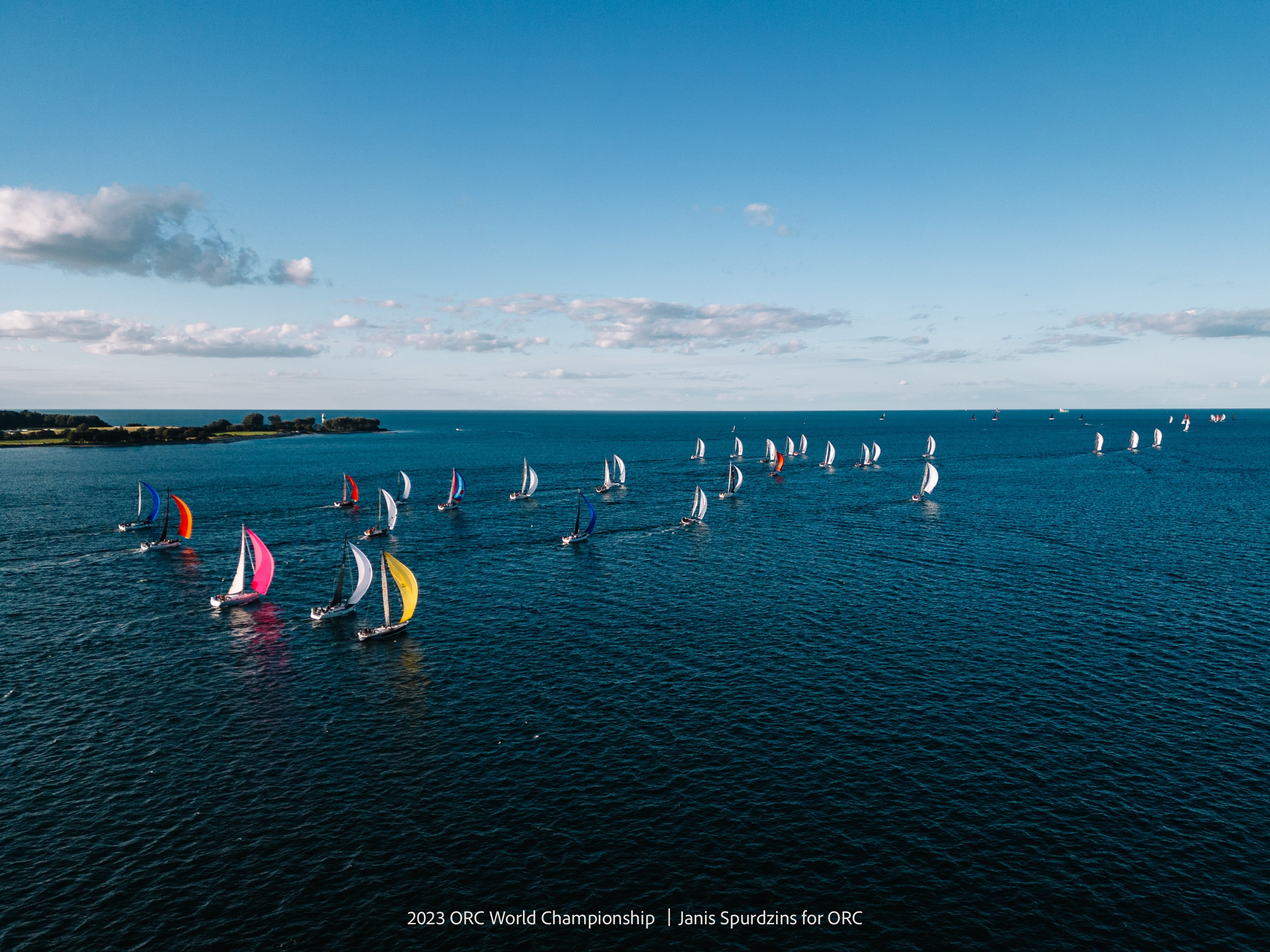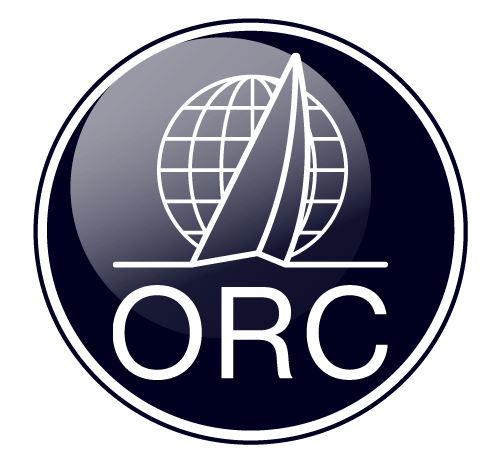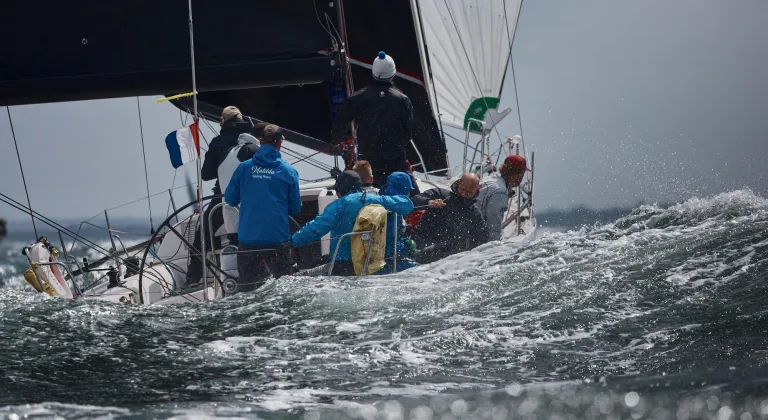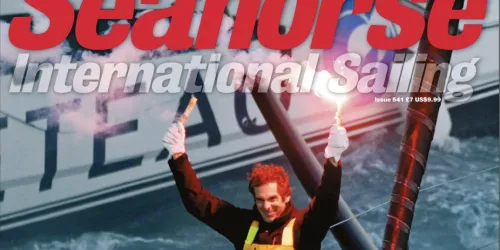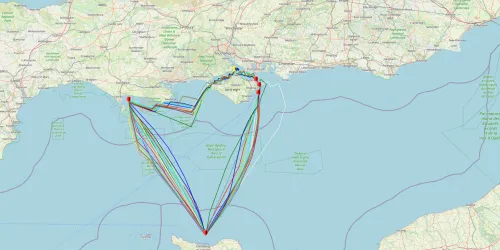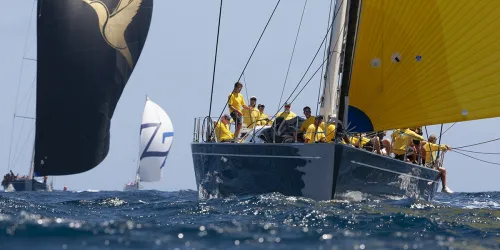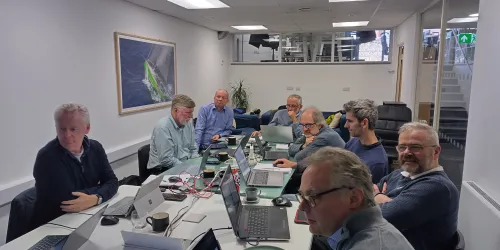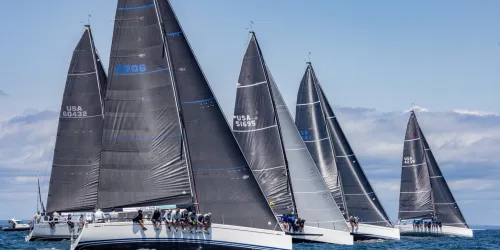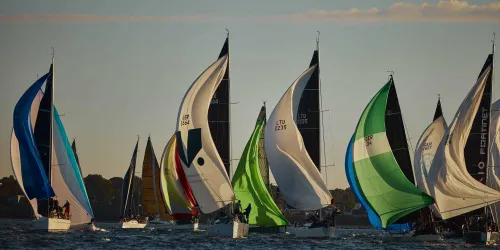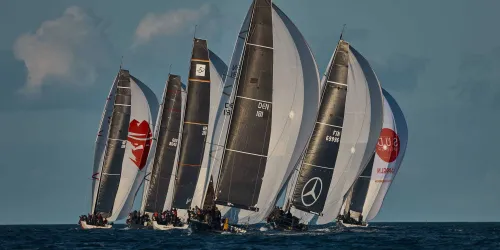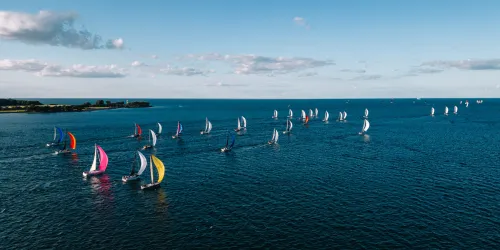Scoring Options
Scoring races to get acceptable race results is the primary function of race management. Competitors expect races to be run competently, and the results to reflect their abilities on the racecourse in a fair and unbiased way. With ORC’s use of scientific modelling of boat performance, this is possible with the correct selection of scoring type that best reflects the race type, the wind conditions and the expectations of the competitors.
One of three main characteristics of ORC rating systems besides science and transparency is the flexibility in scoring options. Since the ORC VPP produces a complete matrix of predicted boat speeds at various wind strengths and directions, ORC rating systems can therefore provide a wide variety of methods to calculate corrected time. This variety may look complex, but it is actually one of the strengths of the ORC rating systems to offer race managers choices that best suit their fleet, their race type and their race conditions. Choosing the best scoring option is therefore finding the right balance between accuracy and simplicity appropriate for the fleet.
The simple options shown on certificates include use of a single-number Time on Distance or Time on Time rating given for basic course types such as:
• Windward/Leeward course - has 50% upwind and 50% downwind race legs
• All Purpose course - includes equal distribution of all wind directions.
To improve accuracy and maximize the ORC rating system's potential, race managers can choose to utilize additional information and opt for Polar Curve Scoring (PCS) or tailor-made scoring options. Besides wind geometries, there are multiple other factors that should influence the selection of the scoring option.
Level of competition – For casual racing in club-level events with limited race committee resources, the simpler scoring options may be the appropriate choice. As the level of competition increases, then more sophisticated systems may be appropriate depending on the expectations of the sailors. For example, by default the windward/leeward races in ORC World and Continental Championships are scored using PCS with constructed courses – this is common for major National Championships and International regattas as well, and even for some local fleet competitions where this level of scoring is accepted and understood.
Class composition – Regardless of the scoring method selected it is important to have the fleet organized into racing groups (e.g. classes, divisions, sections, etc) of similar type. The scoring system works best when like-type and sized boats race each other, particularly when using the most accurate scoring options. Yet for long offshore races there may be a desire to list overall results that include all entered boats besides the results from separate classes.
Time on Distance vs Time on Time – Simple scoring options offer either Time on Distance or Time on Time ratings. The two are equivalent, and the choice can coincide with what the local fleet is accustomed to using. However, if the racing area has current, Time on Time is generally regarded as being more fair.
National Rating Office scoring options - National Rating Offices may publish on their certificates other scoring options. This may include ToD and/or ToT coefficients using different course models as well as multiple ToD and/or ToT coefficients for different wind ranges. The course type used to calculate these ratings and the methods of how they will be applied shall be specified in the Notice of Race and/or Sailing Instructions of the races and events that use them.
Polar Curve Scoring
Polar Curve Scoring is the most powerful engine of the ORC rating systems. It is this unique feature which makes this rule fundamentally different from any other handicap system, as it recognizes that yachts of varied design perform differently when conditions change.
This means that yachts of different designs will have different time allowances in each race depending on the weather conditions and the course configuration for that particular race. For example, heavy under-canvassed boats are slow in light airs but fast in strong winds, boats with deep keels go well to windward, and light boats with small keels will go fast downwind.
Where is it shown on the certificate?
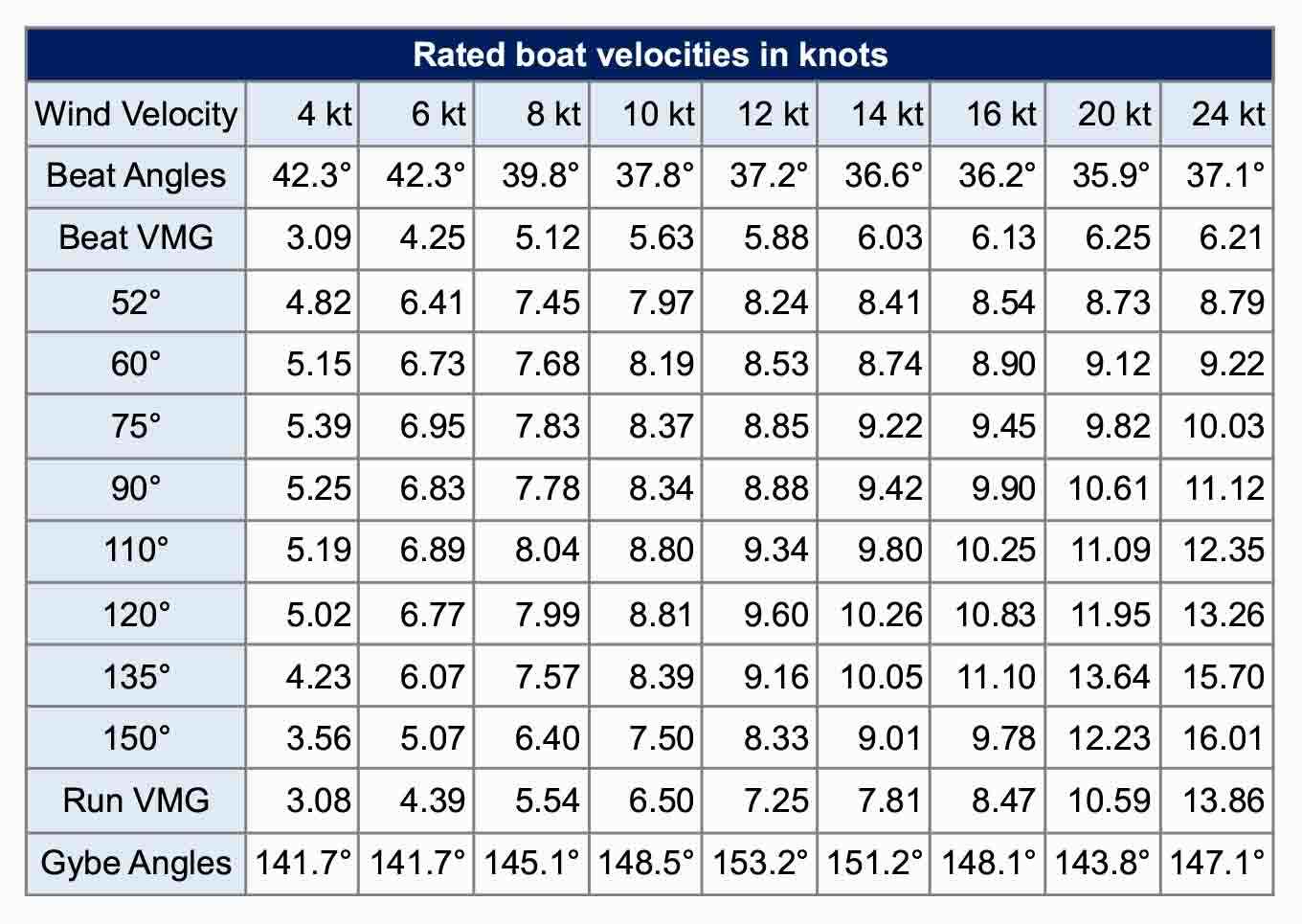
An ORC certificate provides a range of ratings (time allowances expressed in secs/NM) for wind conditions in the range of 4 – 24 knots of true wind speed, and at angles varying from an optimum VMG beat to 52, 60, 75, 90, 110, 120, 135, 150 degrees of true wind angle, as well as the optimum VMG run angle. Additionally, two pre-selected courses are available as:
Windward/leeward (up and down) is a conventional course around windward and leeward marks where the race course consists of 50% upwind and 50% downwind legs. All Purpose includes equal distribution of all wind directions as a hypothetical course type in which the boat circumnavigates a circular island with the true wind direction held constant.
How is it calculated?
Taking for example, two boats with time allowances for All Purpose course their handicaps may be calculated as follows:
| 6 kt | 8 kt | 10 kt | 12 kt | 14 kt | 16 kt | 20 kt | |
| Boat A | 964.1 | 783.9 | 679.9 | 621.5 | 588.0 | 565.9 | 541.2 |
| Boat B | 881.3 | 731.7 | 679.9 | 658.8 | 644.4 | 630.5 | 610.7 |
| Difference | 82.8 | 52.2 | 0.0 | -37.3 | -56.4 | -64.6 | -69.5 |
This would mean that Boat B will give 82.8 seconds per NM to Boat A in light winds, while in strong winds it will be opposite with Boat A giving 69.5 seconds per NM to Boat B.
To score the race, race committee needs to select the wind strength to be used for the scoring. So called Soring Wind is calculated from the performance of the boats. Time allowances for 7 wind speeds may be presented as performance curve.
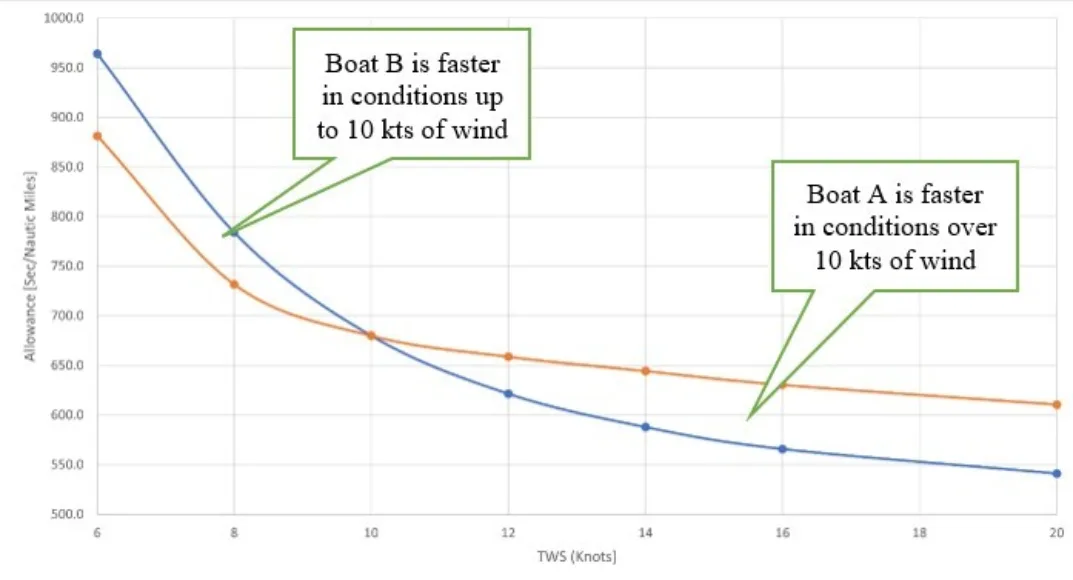
In a typical Performance Curve plot, the vertical axis represents the average speed of the boat around the race course, expressed in seconds per mile. The horizontal axis represents the wind speed in knots. When the finishing time of Yacht A is known, its elapsed time is divided by the distance of the course to determine the average speed in seconds per mile.
For example, if the elapsed time of the boat with the curve shown above is 1 hour 28 minutes 11 seconds and the total length of the course is 8.11 NM, the average s/NM for the boat on that course is:
Elapsed time: 1:28:11 hours = 5291 s
Course length: 8.11 NM
Allowance = Elapsed Time / Course length = 5291/8.11 = 652.4 s/NM
This value is then found on the vertical axis, and the software finds the point where it intersects the performance curve as shown below:
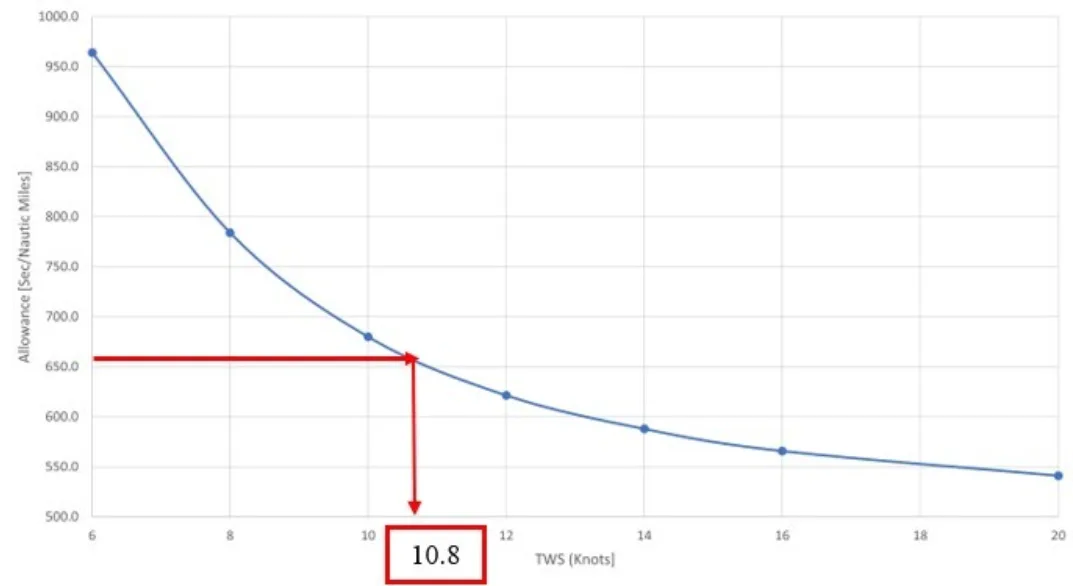
The corresponding point on this curve on the horizontal axis is the so-called Scoring Wind. This means the yacht has completed the course “as if” it has encountered that wind speed. The faster the boat has sailed, the higher the Scoring Wind, which is the primary index used for Polar Curve Scoring: the yacht with the highest Scoring Wind wins the race.
Scoring Wind is intended as an interpolation between time allowances, not an extrapolation. This means that when the Scoring Wind drops below 6 knots or raises above 20 knots, the time allowances used for calculating the corrected times will be those of 6 knots and 20 knots respectively. This does not mean that ORC races need to be stopped (or not started) with wind below 6 knots or above 20. When the Scoring Wind results calculate to be less than 6 knots or more than 20, the corrected time values at these wind speeds are then used.
With the winner known, the remaining rankings in the race are determined as follows: the Scoring Wind of the winner is used as the true wind speed to then calculate the corrected times of the other entries. With that wind on the horizontal axis, the appropriate time allowances are determined on each boat’s curve on the vertical axis. Such a time allowance is then used as a single number Time on Distance coefficient.
Constructed course
Further sophistication of the Polar Curve Scoring and use of full power of the ORC VPP may be achieved by defining the course when the course does not fit with one of the pre-defined course models i.e. any course different from Windward/Leeward course (50/50) or All Purpose with equal distribution of all wind directions.
The use of a constructed course is not as complicated as it may appear. It requires the Race Committee to provide only a little more data in addition to their usual work of setting up the course, following the wind changes, making starts and taking finishing times. ORC provides free PC-based ORC Scorer Software that will do all calculations that enable results to be ready as soon as the elapsed times of the race are entered.
The course may be constructed with these parameters in the ORC Scorer software:
- distance
- course bearing
- wind direction
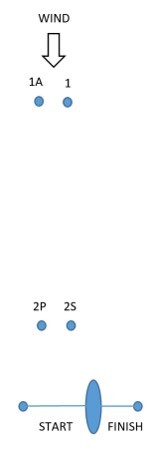
| Leg | Distance | Bearing | Wind direction |
|---|---|---|---|
| Start - 1 | 2.09 NM | 162 | 160 |
| 1 - 1a | 0.06 NM | 060 | 155 |
| 1a - Gate (2-2a) | 1.91 NM | 340 | 155 |
| Gate (2-2a) - 1 | 1.89 NM | 161 | 160 |
| 1 - 1a | 0.06 NM | 0606 | 160 |
| 1a - Gate (2-2a) | 1.91 NM | 340 | 160 |
| Gate (2-2a) - Finish | 0.19 NM | 316 | 160 |
Typical course definition. Distance and bearings of each leg are entered, as is the approximate wind direction. Note wind speed is not entered.Current velocity and direction can also be entered for each leg, if it is known.
From the course constructed as described above, the true wind angle (TWA) is calculated as being the difference between the wind direction and compass bearing of each leg. With this information, a table is made for each boat that describes the theoretical speed of that boat over that course for the range of seven true wind speeds (TWS). Calculated time allowances for these wind speeds are then used to calculate Scoring Wind and corrected times as explained above.
Time on Distance
Corrected time is calculated as follows:
Corrected time = Elapsed time – (ToDdelta * Distance)
Where ToDdelta = ToDthe boat - ToDthe lowest (fastest boat) in the fleet
With Time-on-Distance (ToD) scoring, the coefficient of time allowance of one boat will not change with wind velocity, but will change with the length of the course. One boat will always give to another the same handicap in s/NM, and it is easy to calculate the difference in elapsed time between two boats needed to determine a winner in corrected time.
Where is it shown on the certificate?
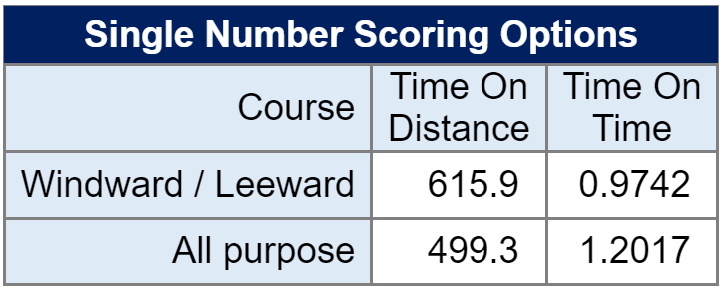
How is it calculated?
ToD coefficients are calculated for the respective course model (Windward/Leeward or All-purpose) with the following wind strength distribution:
| TWS | 6 kt | 8 kt | 10 kt | 12 kt | 14 kt | 16 kt | 20 kt |
|---|---|---|---|---|---|---|---|
| Time allowance% | 5% | 10% | 20% | 30% | 20% | 10% | 5% |
A custom-made ToD coefficient may be calculated using a different wind distribution matrix based on wind historical data or weather forecast for a particular race. Course model to be used shall be specified in the Notice of Race and Sailing Instructions.
Handicap calculator
Time on Time
Corrected time is calculated as follows:
Corrected time = ToT * Elapsed time
With Time-On-Time (ToT) scoring, the time allowance will increase progressively through the duration of the race. Course distance has no effect on the results and need not be measured. Corrected time will depend only on the elapsed time, and the difference between boats may be seen in seconds depending of the duration of the races. The longer the race in time, the larger the handicap.
Where is it shown on the certificate?

How is it calculated?
ToT coefficients are calculated for the respective course model (Windward/Leeward or All-purpose) as follows:
ToT = 600 / ToD
A custom made ToT coefficient may be calculated using conversion factor to the custom made ToD coefficient. A conversion factor different from 600 may be set as ToD representing the middle of the fleet. Use of a different correction factor will not change the place in corrected times, it will only affect the differences in corrected time..
Handicap calculator
ORC Weather Routing Scoring
Weather Routing Scoring (WRS) - Why, What, How & When
Why?
From the very beginning (1978) the ORC handicap system calculated relative handicaps for a mixed fleet which were sensitive to race conditions. The Velocity Prediction Program (VPP) calculated speed polars in a range of wind speeds (TWS) and points of sail (TWA). The intention was to move on from the single number rating systems (eg, meter boats and IOR) which inevitably favour one boat or another in any particular race, the so-called “horses for courses” syndrome.
The Polar Curve Scoring method (PCS) requires two components: the polar speed curves and knowledge of the course geometry and prevailing wind direction and speed. For short inshore races the course and wind data can be entered post-race by the scorer. But, for coastal and offshore races these methods were not deliverable, so the single number All Purpose Handicap (APH) was used. Yet the fleet was still exposed to the “horses for courses” effect.
By 2023 the granularity and reliability of coastal weather forecasts and tidal predictions had reached a level where the weather forecast could possibly be used to provide the wind strength and direction to score the race. ORC in cooperation with race organizers began to evaluate this approach.
What?
In 2024 ORC, in partnership with PredictWind, built a scoring system that generated a pre-race handicap sheet based on a chosen weather forecast. This was used to score or shadow score 50 regattas in 2024, some with fleets of over 300 boats.
The process is as follows: a few hours before the start; the race is simulated for every boat using its ORC polar curves, and the weather forecast, charting and routing engine provided by PredictWind. These simulations deliver not only a predicted route and elapsed time, but also how long each boat spends on each point of sail in each TWS and TWA band. The TWA and TWS distribution are therefore unique to each boat and the ORC Scorer software uses this instead of the All Purpose Handicap (APH) to generate the scratch sheet.
- A few hours before the race start the Race Scorer will use the ORC Weather Routing Scoring system to simulate the race for every boat in the fleet.
- The optimum route for each boat will be simulated.
- The simulation delivers the track of the optimised route, a Predicted Elapsed Time (PET) and, most importantly, the associated distribution of True Wind Speed (TWS) and True Wind Angle (TWA).
- The Time Correction Factor (TCF) for each boat to use in the race will be calculated from the ratio of the boats PET to the scratch boat. The scratch boat may be a member of the fleet, or an average of the PET’s
Just like any other race, each boat leaves the start line knowing the TCFs of all her competitors, based on the anticipated race conditions and the boats ORC polar table. If the forecast weather eventuates, there is no better way to set handicaps that account for the performance differences between the boats. If the weather during the race varies from the forecast, our analysis of the races to date shows that the WRS TCF is always better matched to the race conditions than the All Purpose Handicap.
How?
The ORC Scorer or the ORC RaceFlow app performs the entire process. The app combines four processes:
- A Race Management component that deals with race timing, course setting, etc.
- Communication with the ORC Certificate database to gather the latest certificates for the entrants. The certificate contains the polar speed tables.
- Communication with the PredictWind server, uploading the course and start time and the fleet polars, retrieving the routing data, track, speed, TWS, TWA, current set and strength and predicted elapsed time.
- Displaying the routing data, etc. for the race officer to check.
- Preparing the table of handicaps (scratch sheet) and time allowance tables for the competitors.
When?
Our analysis of these 50 regattas shows that even when the forecast is less than perfect the WRS predictions of elapsed time are closer to the actual elapsed times than that derived from the APH, and even the pre-calculated historic weather-based course options that are available in the USA.
In short, WRS levels the playing field for offshore races in a way the single number APH or historic weather-based course options never can. Situations where a building or dying breeze approaching the finish favours the smaller or larger boats are mitigated. Races where boats with sail wardrobes optimised for reaching are not favoured if these conditions occur for long periods of the race.
How do we participate in WRS?
(1) Apply at the WRS application found on the ORC website: https://sas.orc.org/wrsappl.php.
Race Organisers may apply to use WRS to score, or shadow score, an event.
(2) A web-based app ‘RaceFlow' is under development and expected to be available for the 2025 season. The intent is for this to be made broadly available to all users with guidance for its use to be described in the 2025 editions of the ORC Race Management Guidebooks.
Typical output from the scoring program shows the predicted tracks.
The land avoidance is such that even a beat out of the western Solent can be simulated.

Whilst the tracks are visually helpful the scoring program only uses the distribution of time spent in each TWS and TWA. Typical results are shown below, this shows the competitors saw a mix of beating and running in 10-16 knots of wind, with little or no reaching.


WRS may be unnerving for those accustomed to single number handicaps because the amount of time you give or get from your rivals varies from race to race. Questions may arise, such as ‘Has the choice of forecast or its reliability pushed you down the fleet compared to using APH?’ ‘How do I seek redress if this has happened?’ and so on.
Our analysis to date shows that:
WRS will never let a badly sailed boat win the race.
The parameters of the race simulations and TCF’s are published before the race, just like before, only now there is no reason to approach the start fearful that the conditions do not suit your boat. Even if the race conditions differ from the forecast your simulated race will still be more appropriate than the APH or a historic weather-based course option.
If, post-race, an error is found, it can be corrected, in the same way that a race is re-scored when a measurement error is found.
This approach requires a change of mindset. The real race conditions will never exactly match a pre-determined distribution of TWA TWS (e.g. APH). Even if the simulation is less than perfect the WRS TCF will have done a better job of matching the race conditions.
Further information is available in the ORC Weather Routing Scoring Q & A section.
